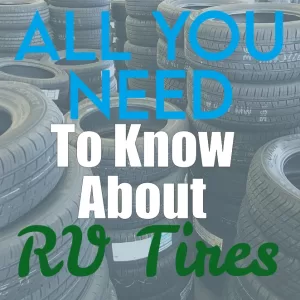 As an RV owner, one of the most important things you need to pay attention to is your vehicle’s tires. They are not only responsible for supporting your RV’s weight but also for ensuring your safety and comfort on the road.
As an RV owner, one of the most important things you need to pay attention to is your vehicle’s tires. They are not only responsible for supporting your RV’s weight but also for ensuring your safety and comfort on the road.
But with so many different sizes and types of RV tires available, it can be overwhelming to choose the right one for your vehicle. In this article, we will go over everything you need to know about RV tire sizes to help you make an informed decision.
That is because, as you will soon find out, not all RV tires are the same. As with most things in life, there are different qualities and construction methods to RV tires. That’s why it is important to choose the right tires – so that you don’t end up stranded somewhere, or worse.
What are RV Tire Sizes?
RV tire sizes are a combination of numbers and letters printed on the tire’s sidewall, indicating its width, aspect ratio, tire type, construction, and wheel diameter. The first letter signifies the tire type, with “ST” representing special trailer tires and “LT” representing light truck tires. The next number is the tire width in millimeters, followed by a slash and the aspect ratio, which is the ratio of the tire’s height to its width. The next letter represents the tire’s construction, with “R” indicating radial tires and “D” indicating bias ply tires. Finally, the last number signifies the wheel diameter in inches.
For instance, if you have an “ST205/75R14” tire, the “ST” means that it is a special trailer tire, 205 is the tire’s width in millimeters, 75 is the aspect ratio, “R” means radial construction, and 14 is the wheel diameter.
How to Choose the Right RV Tire Size?
Choosing the right tire size for your RV is crucial for your safety, comfort, and vehicle performance. Here are some things to consider when selecting the correct tire size:
- Your RV’s weight: It’s essential to choose a tire size that can support the weight of your RV. The tire’s load-carrying capacity is indicated by its load range, which refers to the maximum weight the tire can support at a specific inflation pressure.
- Type of driving: The type of driving you’ll be doing also influences your tire choice. If you’re traveling on paved roads, you can choose a tire with a lower profile, but if you plan to go off-road or on rough terrain, a tire with a higher profile will be better.
- RV manufacturer recommendations: The manufacturer’s specifications and recommendations for tire size should be consulted before making any changes or upgrades.
- Your personal preferences: You may also have personal preferences, such as a specific brand or style of tire, that should be considered.
Consulting with an expert in RV tires is the best way to ensure that you choose the correct tire size for your specific needs.
Common RV Tire Sizes
There are several standard RV tire sizes that are commonly used in the industry. Here are some of the most popular sizes:
- ST205/75R14
- ST225/75R15
- ST235/80R16
- LT225/75R16
- LT235/85R16
It’s essential to note that not all RVs use these tire sizes, and it’s always best to check your owner’s manual or consult with a professional to confirm your RV’s tire size.
When Should You Replace Your RV Tires?
RV tires can last up to ten years, but their lifespan varies depending on various factors such as the weather conditions, tire usage, and maintenance. Regardless of the amount of remaining tread, it’s essential to replace your RV tires every five to seven years.
It’s crucial to inspect your tires regularly for signs of wear or damage, such as cracks, bulges, or punctures. Damaged tires should be replaced immediately, and any issues with tire wear or pressure should be addressed before driving your RV.
Proper Maintenance
Proper maintenance of your RV tires is essential for their longevity and safety. Here are some tips to keep in mind:
- Check the tire pressure regularly: Underinflated tires can lead to poor fuel economy, decreased handling, and even blowouts. Overinflated tires can result in a harsher ride, decreased traction, and increased wear on the center of the tire. Refer to your owner’s manual for the recommended tire pressure and check it at least once a month.
- Inspect the tires regularly: Inspect your RV’s tires regularly for signs of damage, such as cracks, bulges, cuts, or punctures. Check the tread depth and replace the tires when they have less than 4/32 inches of tread remaining.
- Rotate the tires: Rotating your tires can promote even wear and extend their lifespan. Refer to your owner’s manual for the recommended rotation pattern and frequency.
- Store your RV properly: When not in use, store your RV in a dry and cool place, away from direct sunlight and extreme temperatures. Cover the tires to protect them from UV damage and prevent them from drying out.
- Avoid overloading: Overloading your RV can result in increased wear and tear on the tires, leading to potential blowouts or accidents. Follow the manufacturer’s recommendations for your RV’s weight capacity and pack accordingly.
Upgrading Your RV Tire Size
If you want to upgrade your RV’s tire size, there are some things to consider. A larger tire size can provide better traction, stability, and load-carrying capacity, but it can also impact your RV’s performance, handling, and fuel economy. Before making any changes, consult with a professional to ensure that the new tire size is compatible with your RV and that any modifications are safe and legal.
Choosing the right tire size for your RV is essential for your safety, comfort, and vehicle performance. Understanding the tire size designation and consulting with an expert can help you make an informed decision. Proper maintenance of your RV’s tires can extend their lifespan and keep you safe on the road. Remember to check the tire pressure regularly, inspect the tires for signs of damage, rotate the tires, store your RV properly, and avoid overloading.

